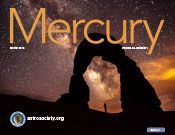Winter 2015 - Volume 44, Number 1

Table of Contents
[19] Begging for Planets, HAT in Hand, Dayton Martindale
The charm of small telescopes in the search for extrasolar planets is that the instrumentation is affordable.
[27] Jobs That Are Out of This World, Peter Michaud
Not an astronomer? No worries. There are plenty of other jobs available at observatories around the world.
[31] YouTube for Science, Anna H. Spitz
Through entertainment, YouTube science videos engage and promote active thinking and reach the next generation of young scientists.
[39] Astronomy in the News
Jupiter’s red spot is likely a sunburn, Kepler finds three newly validated planets located in their distant suns’ habitable zone, and a strange galaxy perplexes astronomers. These are some of the items that recently made news in the astronomical community.
Departments
[4] Perspectives, Paul Deans
Strange New Worlds
[5] First Word, Linda Shore
True Grit
[7] Annals of Astronomy, Clifford J. Cunningham
First Spectrum of a Nebula
[8] Astronomer’s Notebook, Jennifer Birriel
Comets and Night Sky Brightness
[10] Planetary Perspectives, Emily Joseph
Soft Landing on a Comet
[11] Strange New Worlds, Trudy E. Bell
Wild Weather on WASP-43b
[13] Armchair Astrophysics, Christopher Wanjek
Aligning Quasars: Spooky or Just Spurious?
[14] Education Matters, Brian Kruse
Thinking For Themselves
[16] Reaching Out, Bethany Cobb
Astronomical Fashion
[17] Societal Impact, Noelle and Alex Filippenko
Epic Pi Day is Coming Soon!
[48] ASP Tidings
A New Publisher for PASP
[50] Sky Sights, Paul Deans
April's Lunar Eclipse
[53] Reflections, Jet Propulsion Laboratory
A New View of Europa
Begging for Planets, HAT in Hand
by Dayton Martindale
“Do you see that?” Professor Gaspar Bakos asked, gesturing towards his computer screen. From his office at Princeton University he is able to manage two telescope mounts of his own design in Namibia, surrounded by an electric fence that deters inquisitive monkeys from reprogramming things.
The two units in Namibia make up one-third of the HATSouth system; “HAT” stands for “Hungarian-made Automated Telescope,” and “South” refers to the hemisphere. Two other sets of two can be found in Chile and Australia.
The original (non-southern) HAT model, HAT-1, was stationed at Kitt Peak’s Steward Observatory in Arizona. It was suited to measure the incoming light — the flux — from stars, and how that flux varies. At the time, Bakos wrote that while HAT was “suitable for exoplanet search via transits,” he planned to “concentrate on a broader range of variabilities.” Not long after this paper was published, the suggestions of his colleagues led him to drop that “broader range” and use an updated system of HAT telescopes almost exclusively for exoplanet research.
Jobs That Are Out of this World
by Peter Michaud
Anyone familiar with astronomical observatories knows that there are myriad amazing jobs in and around giant telescopes. For most of us, the best part is that the vast majority of these jobs do not require a PhD in astrophysics!
“It’s painfully clear that students don’t have any idea what observatories have to offer when it comes to exciting and diverse career opportunities,” says Gemini’s Director Markus Kissler-Patig. “Especially in remote local host communities like Hawai‘i and Chile.”
This reality sparked a desire among many Gemini Observatory staff to help build awareness of the people and jobs that make an astronomical observatory click.
YouTube for Science
by Anna H. Spitz
YouTube videos reach more than one billion viewers per month. These channels range from silly and personal to serious, educational, and even corporate. The number of viewers dwarfs cable or other networks, particularly in the youth and 18- to 34-age range. This large platform can offer an effective and exciting way to communicate astronomy (and other topics) to the public.
Science YouTubers, defined here as those who post science videos on YouTube, include formal and informal presenters, individuals, and institutions. The variety of channels is immense. Many organizations and individuals offer traditional lecture- or interview-style formats, while others use less formal methods infused with humor. Some of the most popular and engaging channels are not affiliated with large organizations and produce videos that appeal to audiences attracted to a more informal or irreverent style.
Jupiter’s Red Spot is Likely a Sunburn, Not a Blush
Jet Propulsion Laboratory
The ruddy color of Jupiter’s Great Red Spot is likely a product of simple chemicals being broken apart by sunlight in the planet’s upper atmosphere, according to a new analysis of data from NASA’s Cassini mission. The results contradict the other leading theory for the origin of the spot’s striking color — that the reddish chemicals come from beneath Jupiter’s clouds.
Kevin Baines, a Cassini team scientist based at NASA’s Jet Propulsion Laboratory Baines, and JPL colleagues Bob Carlson and Tom Momary, arrived at their conclusions using a combination of data from Cassini’s December 2000 Jupiter flyby and laboratory experiments.
In the lab, the researchers blasted ammonia and acetylene gases — chemicals known to exist on Jupiter — with ultraviolet light, to simulate the Sun’s effects on these materials at the extreme heights of clouds in the Great Red Spot. This produced a reddish material, which the team compared to the Great Red Spot as observed by Cassini’s Visible and Infrared Mapping Spectrometer (VIMS). They found that the light-scattering properties of their red concoction nicely matched a model of the Great Red Spot in which the red-colored material is confined to the uppermost reaches of the giant cyclone-like feature.
“Our models suggest most of the Great Red Spot is actually pretty bland in color, beneath the upper cloud layer of reddish material,” said Baines. “Under the reddish ‘sunburn’ the clouds are probably whitish or grayish.” A coloring agent confined to the top of the clouds would be inconsistent with the competing theory, which posits that the spot’s red color is due to upwelling chemicals formed deep beneath the visible cloud layers, he said.
